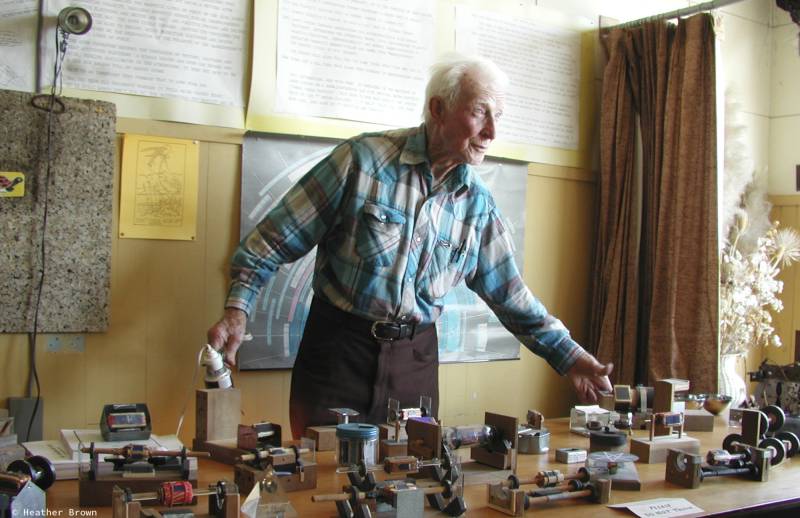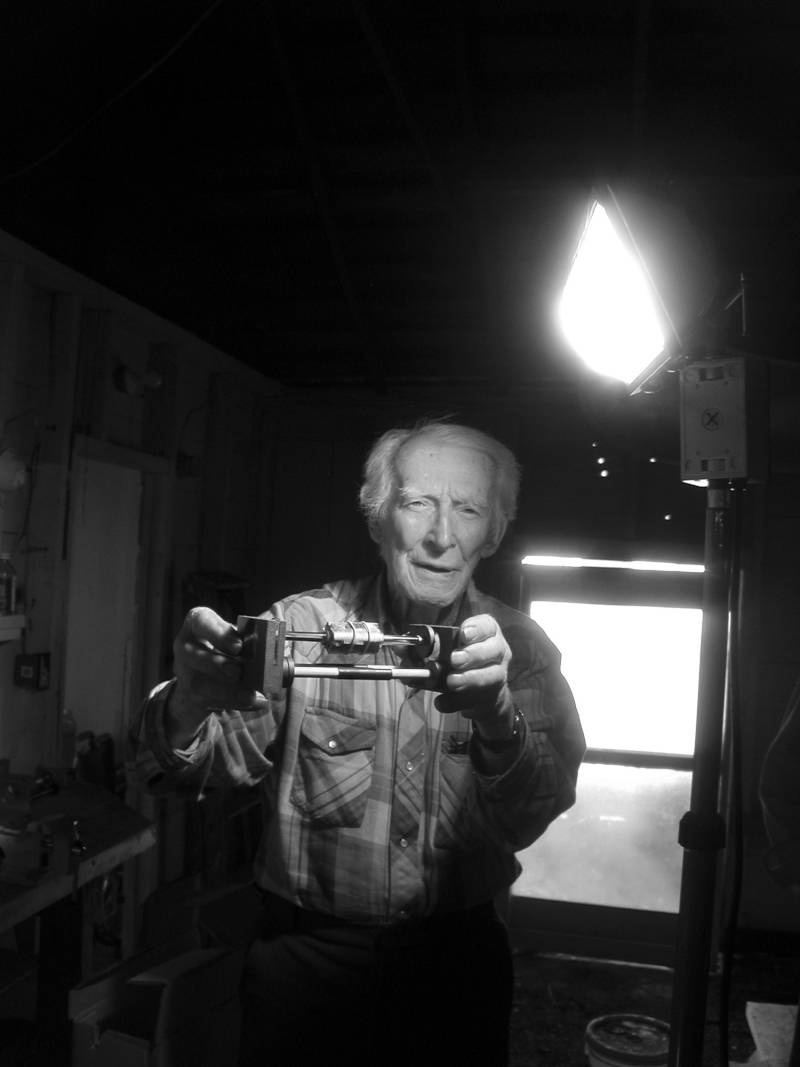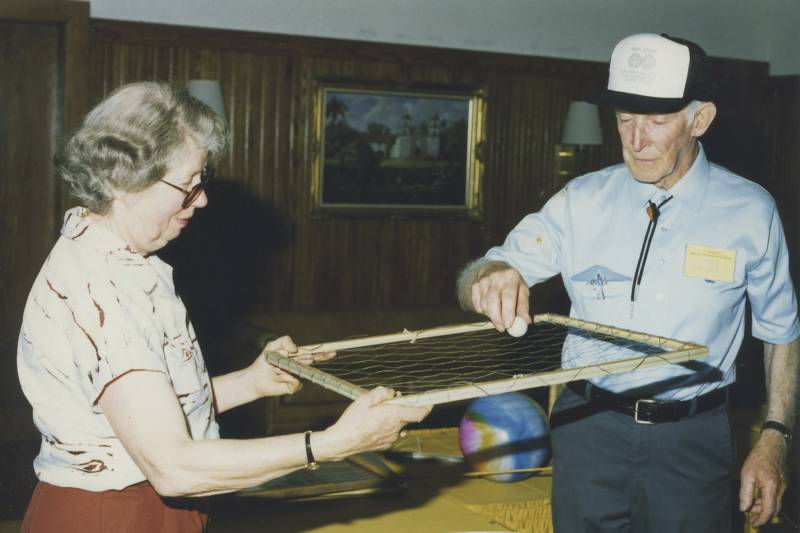Walking into the Larry Spring Museum in downtown Fort Bragg is an experience in sensory overload. The space is small, just two rooms, but they are full of interesting objects that call for closer attention. The central table is covered in small mechanisms that whirl when a direct light shines on them. Other tactile exhibits line the walls and the shelves are covered in whimsical wooden figurines that look like woodland creatures.
How Fort Bragg's Larry Spring Museum Preserves Creativity in California

“It’s one of those little treasures that’s off the beaten path,” said Anne Maureen McKeating, the museum’s executive director. “And I think when people discover it, they’re pretty happy with themselves.”
In the corner, a video of an older man in a blue checked shirt runs on a loop. He beckons viewers inside, saying:
“Hello, you folks seem to be interested in what’s in this shop, this electromagnetic experimental shop. Why don’t you come on in, and I’ll show you a lot more.”
This is Larry Spring, the man behind this collection. Spring spent most of his life in Fort Bragg, Mendocino County. He owned the Larry Spring Zenith Television Shop, where he sold and repaired TVs. Now, his shop is the museum. He also installed antennas in people’s homes.
“He was the guy that brought TV to the North Coast,” McKeating said.
Through that work, he got curious about radio waves and electromagnetism. As a boy, he’d been fascinated by radios, tinkering with oatmeal boxes, wire coils and galena crystals to pick up radio stations from San Francisco. Later, he was a pilot during WWII, specializing in radio wave transmission. He loved to experiment, observe and make improvements, but he had no formal training in science. Once he got access to larger TV antennas, his hobby felt more meaningful. He thought what he was observing differed a bit from what traditional textbooks teach about electromagnetic waves.
“In his library, I have a whole bunch of textbooks filled with marginalia and corrections around how electromagnetism works,” McKeating said. “So, for him, electromagnetism is a result of two weightless, massless spheres, that he calls magnespheres, and they change in size and speed according to their purpose. So rather than, the waveform or the particle we traditionally understand as being energy, for him, it’s these magnespheres.”
While Spring’s theories may have deviated from traditional science, McKeating admires his boundless curiosity and desire to explain the world in simple terms that people from any background can understand.
“Larry didn’t have a lot of use for the world being described in mathematics. That model for him was very dense,” McKeating said. For Larry, it was his keen powers of observation that made the world real to him.”
He loved physics. He wanted to make the invisible world visible. As he got older, he increasingly spent his time at his shop building models and holding three-hour lectures about his theories that no one could interrupt. He was able to devote his time in this way, in part because he had done well in real estate.
“He worked in real estate because, yes, he wanted to gain some money, but also, he was a good citizen and really believed in sharing the wealth,” McKeating said. “If he knew of local families [for whom their] homes had gone into foreclosure, he would buy up the homes and give them back to the families.”
And, he earned enough from his real estate business to close the TV repair store and turn it into “a school of common sense physics.”
The Larry Spring Museum is essentially a display of his models, collections and theories. McKeating cautions that not all Spring’s theories made perfect sense, but the items he amassed over his lifetime have their unique charm.
“It’s a constellation of objects, one might say, an amalgamation of art and science and all that lies in between,” McKeating said. “And it’s kind of the in-between-ness that people really are interested in.”
That’s certainly true for her. She came by this collection in a roundabout way. Her friend, Heather Brown, worked with Spring. When he died in 2009, he left his collection and the building to Brown. McKeating volunteered to help Brown sort and organize all of the items. But when Brown herself passed away a few years later, McKeating’s name was on the will, and she inherited it.
“I am interested in odd little collections and place-based production,” McKeating said. “So the collection itself is right up my alley. I love the models. There [are] a lot of paintings that Larry did as well.”
Some of the most delightful things in the museum are Spring’s solar motors. He attached solar panels to different models that then spin an object or play music using magnetic propulsion.
“He wanted to know how the world worked,” McKeating said. “And these are the ways in which he decided were a good way for him to learn. I think they’re wonderful. They’re like little kinetic sculptures to me, and he’s clearly taken time to make them aesthetically pleasing.”
The little woods creatures are also delightful, but Spring didn’t think of them as sculptures. For him, they are an extension of his keen powers of observation — he’d notice sticks in the woods that resembled a beaver or a dancing person and then enhance those features until they looked even more like what he’d observed.

“But he didn’t identify as an artist,” McKeating said. “He identified as an experimenter. So it’s pretty interesting because a lot of people experience this place as just kind of an overwhelming curiosity cabinet.”
Other visitor favorites include a “rock dinner party” and Spring’s “picture rocks.” The rock dinner party is spread out on a yellow Formica table. Each item on the table looks like a common element of a dinner party — glasses full of wine or water, slices of ham and cheese, brussels sprouts — but they are actually rocks. It’s a delightful illusion.
The “picture rocks” are cross sections of rock that somehow look like landscape paintings.
“His label for this particular cabinet is, ‘the oldest pictures in the world painted by Mother Nature millions of years ago,’” McKeating said. “They do look like pictures. People use [their] imagination to create something out of what they’re seeing.”
One of the things McKeating loves most about the items in the museum is their impermanence. Spring was a regular guy, curious about the world around him and creating models out of the materials he had available to him — pop tops, music boxes, tinfoil. That makes it a challenge to maintain the items on display, some of which are already deteriorating.
“I don’t think it’s a bad thing to show the passage of time with these kinds of artifacts,” McKeating said. “In a sense, I look at it as curated decay. Its value is in being all together in this particular place, in this particular building.”

And Larry is still in the building, too. He was cremated, and his ashes are kept inside a wood burl lamp standing on the desk, watching over the place he loved so much.
The Larry Spring Museum is a volunteer-run non-profit museum in Fort Bragg and is open by appointment.
